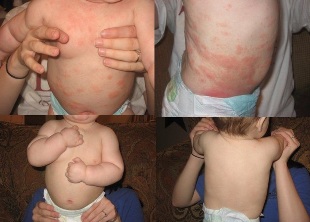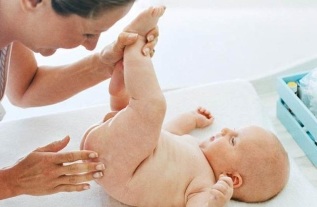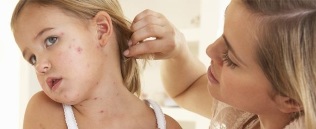Psoriasis in children diagnosed at any age. It is a chronic disease can hit even the babies and the infants, in recent years, cases in children psoriasis in young children of preschool age. At the onset of the first signs of the disease is necessary to start a full course of treatment. Earlier will be able to achieve the state of remission stable, the better for the health of the child.

The reasons of occurrence of children of psoriasis
Children psoriasis has a systemic nature. Its development lead to disruption in the functioning of the immune system when the body can not withstand the harmful effects of external factors.
The doctors are not able to highlight a cause, causing the appearance of the disease in the child. But there are a number of scientific assumptions:
- A hereditary predisposition – if the family have been diagnosed with a case of psoriasis, the risk of the development of the child increases by 30%. When the disease suffer both parents, it increases up to 80%. But she only inherits the predisposition to the disease, and therefore, with good care of the child, there are chances to avoid it.
- The violation of the activity of the nervous system – the negative experiences, stress, changes in life (change of school, the birth of a second child) can induce the onset of the disease.
- Violations of the metabolic processes deficiency – vitamins, oligo-elements.
- The presence of helminth parasites to absorb useful substances, release large amounts of toxins, a harmful effect on the body of a child. Often appear of the skin reactions, and psoriasis.
- The infection in childhood, psoriasis often appears after the transfer of infectious diseases. It can cause a sore throat, the flu, the common cold.
- The dysfunction of the endocrine system – hormonal imbalance causes psoriasis.
- Diseases of the liver – when violations of this body, the body cannot neutralize toxins, which can result in the development of psoriasis. The more often the psoriasis in children is diagnosed for the first time in the cold season. Greatly increases the risk of its development and injury to the skin.
The symptoms of psoriasis in children

Signs of psoriasis in children differ significantly in the symptoms of this disease in the adult. In children at the initial stage of red appear rash in the folds of the skin (in the buttocks, armpits), on the head, face, and the genitals. It is located in places subject to constant friction of the clothes. Rarely a rash occurs on the palms of the hands and feet. The rash looks like intertrigo, but it has the main symptom of psoriasis – horny ball of the papules exfoliate, appears flaking. Gradually stretch the skin is covered with a layer of scales from the crust. Simple small papules merge into conglomerates. Their size gradually increases, covering large areas of the epidermis. In most cases, the rash itchy, providing the child an embarrassment. He brushes the papules, at the risk of infect.
The stage of children of psoriasis and their symptoms
- Progressive – the emergence of the small rash is red or bright pink color. It is irritating, peeling, expands and extends on the skin. Soon a rash covered with cracks starts to bleed a little. Unlike adults, children have practically not a phenomenon stearic spots, film terminal. In severe forms of the advanced stage in the child increases the temperature of the body, condenses to the surface of the epidermis, increase the lymph nodes, there is a swelling of the skin, a strong redness.
- Fixed – the formation of new lesions and their growth stops, decreases the intensity of the shelling.
- Regressive – the eruption begins gradually dissolvere. After his disappearance on the skin appear depigmented bands.
When the complete disappearance of the symptoms of the disease comes into remission. Its duration depends on the characteristics of care of the child, in particular of the power supply. A recurrence of the disease in children is often a consequence of the intensification of infectious diseases.
Types of children psoriasis
Secrete different types of psoriasis in children. They are classified independently of the characteristics of the symptomatology and localization of the lesions. The main forms of the disease:
- Libero psoriasis. You receive in children up to one year. The eruptions are localized primarily in the gluteus maximus area. Because of the constant contact with feces and urine, as a result of rubbing the skin layers in this area irritated, consequently, the disease difficult to diagnose. Often, the parents take this rash to dermatitis, which can start a treatment early.
- Tabula (normal) psoriasis. The most common form of the disease in children. Its characteristic symptoms on the surface of the skin to form patches of red color. First of all, they are small, but rather rapidly increasing in diameter, begin to peel off. The base of the papules has a dense texture. From above, they are spongy bone covered with a layer of scales, which can be easily separated. Locate the Tabula papules on different parts of the body, but most often in the bend of the elbows and knees, the scalp.
- The guttate psoriasis. The body is covered with a large number of lesions, which form resemble gout, with a small size and a convex shape. Papules rise above the surface of the epidermis, cortices. They cover the head, hands and feet, as well as the torso. The rash can disappear by itself or turn into a tabula psoriasis. At the age of 4-5 years, this form of the disease is caused streptococcal infection.
- Generativus pustular psoriasis. Develops quite suddenly and very quickly. For a short period of time, large areas of the skin is inflamed, covered ulcera. The dead zone of the epidermis badly. This form of psoriasis is dangerous and causes serious complications. It can lead to diseases of internal organs, especially the kidneys, the heart.
- pustular psoriasis.Affects children, older than 7 years. In infants and children of preschool age are very rare. It is a severe form of the disease, in which you receive a swelling of the skin, and its surface is covered with bubbles, filled with communicable exudo. Often accompanied by inflammation of the lymph nodes.
- The erythrodermic psoriasis. Very dangerous, provocaverunt praesent of thermoregulation of the body. Manifests itself in generativus inflammation of the epidermis, intense шелушении. Accompanied by strong itching, painful sensations. Large areas of the skin begin to flake. Can be fatal, especially if the child is small.
- Psoriasis of the bending of the surface. Appears on the bending of the body, most often in the area of the inside of the thighs, the groin and genitals. The body is covered with patches of red color. They are smooth and do cortices, but a little convex.
- Arthropathic psoriasis. Affects the joints. Signs of this form of the disease – the aching, they cease to be mobile, the joints and fingers are swollen and swell. The knees, the feet, ankles, wrists aching, a general feeling of being unwell. It may appear a conjunctivitis. According to the current type of psoriasis, it is divided into types: winter or summer regardless of the season, when the occurrence of a relapse, most of the children in the form of the winter; for the first time appeared – when symptoms appear for the first time; constantly recurring – the worsening of the disease; the indefinite shape.
- The nail psoriasis. Hits clavum of the plate. Its symptoms depend on the form. Secrete the following varieties:
- naperstkovidnym on the surface of the nails are formed of small deepen, because of what visually they become like a thimble;
- nicomedes – nails exfoliate of the lodge very quickly;
- onycholysis – nail gradually exfoliate the lodge, the inflammatory process are missing, around the base of the nail, you get a yellow border-pink;
- trachyonychia the nail thickens, becomes rough, the surface is wave-shaped, the edges are lifted;
- hemorrhaging subungual below the surface of the nail appear to be bands and patches of red-pink tones;
- paronychia psoriatic – skin around the nail and the finger thicken is accompanied by an intense inflammatory process.
The diagnosis of children psoriasis
The diagnosis of psoriasis is a dermatologist. He proceeded to the inspection of the child, precise, with the appearance of the rash, how to manifest the disease, there are in the family, the people suffering from this disease. The diagnosis of children, particularly before the age of 1 year exclusively visual tours difficult, because they often do not have the classic symptoms of the disease: stearic spot terminal film " and "bloody rose". Exactly are you sure that you have psoriasis will allow the analysis of scrapings taken from the surface of lesions.
The treatment of psoriasis in children

The children, psoriasis patients need in the treatment. To quickly reach a state of remission will help to a systemic therapy, simultaneously aimed at eliminating the symptoms and strengthen the body as a whole. A review of the main methods of treatment.
Medicines for external use
Are effective for the removal of papules, on the skin. This group includes:
- established salicylic ointment 1-2% - against-indicated in infants;
- sulphur-tar ointment 2-3%; boric ointment;
- glucocorticoid ointments 0.5% – "Locacorten", "Flucinar", "Prednisolone";
- phosphodiesterase inhibitors – papaverina ointment 1%, and teofillina ointment 5% for the treatment of psoriasis, hit pilosus part of the head;
- steroid creams and ointments, – "Instructions" And", "Haec solutio" and other ointments of psoriasis;
- heparin ointment – old plates.
Medicines for internal use:
- desensitizing tools – three times a day shows to make a solution of calcium gluconate to 5% of a teaspoon precise time the doctor;
- sedative – children of tincture of valerian;
- antihistamines, drugs to relieve itching – 7-10 days to take "Tavegil", "Suprastin", highs are introduced injection, when most of the light – can prescribe the pill;
- tranquilizers – in rare cases are attributed to the older children, you can apply "Tazepam", "Seduksen";
- vitamins to strengthen the immune system – ascorbic acid, vitamin B12, B15, D, A, E, drink three times a day to several months;
- pyrogenic drugs – to activate the protective functions of the body, the normalization of the permeability of the vessels, prescribe 8-10 injection "Pirogenala", the children of more than 3 years;
- glucocorticoids are appointed in serious cases, the rate of 2-3 weeks, with a gradual reduction of the dose.
Good nutrition
For, as quickly as possible to cure the psoriasis and achieve a state of remission, it is necessary to respect a correct diet:
- to exclude the pastries, pastries, sweet, fatty and fried meals, chocolate;
- limit the consumption of citrus fruits;
- drink enough fluid;
- replace sugary drinks with herbal tea;
- the basic food of vegetables, herbs, recenter fruit juice, diet of meat, lean fish.
Prevention

In order to minimize the risk of the disease and prolong the period of remission, follow some simple rules:
- when bathing do not use aggressive means and hard wipes;
- teach the child to avoid cuts, burns, wounds of the skin, taking care of the child in contact with the skin and the direct rays of the sun;
- preferably, choose clothes from natural fabrics; follow the diet of the child; gently picking up medications.
- try to you to ensure that your child has dominated to a positive emotional state.
If you have a minimum of suspicion, that the child appeared psoriasis, consult a dermatologist. This is a serious disease, so how is it treated can mean that a qualified doctor. Not self-medicating, in effect, the sooner it will be accepted effective therapy, more quickly manage to achieve a state of remission stable. Although psoriasis cannot be cured, appropriate and timely approach, you can reduce the number of relapses of the disease.
























